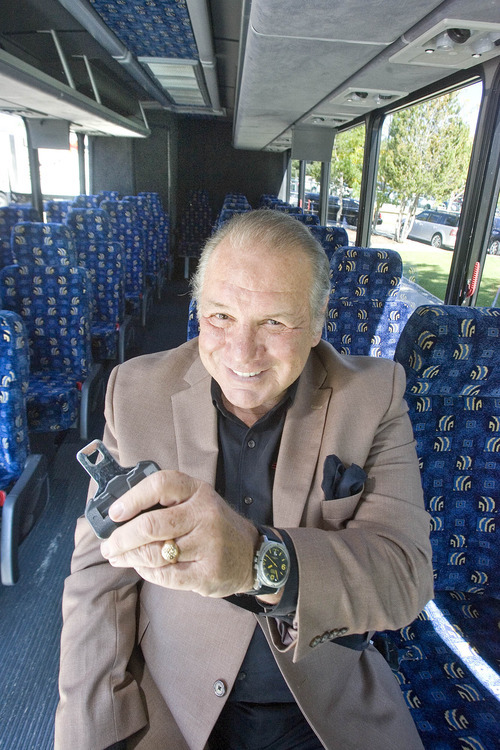This is an archived article that was published on sltrib.com in 2012, and information in the article may be outdated. It is provided only for personal research purposes and may not be reprinted.
One of Utah's largest bus companies is in the process of equipping all of its vehicles with seat belts despite the fact that no federal or state regulations require them.
"It didn't come to me in a vision," said All Resort Group CEO Richard Bizzaro, whose holdings include Lewis Stages. "It seemed like the right thing to do. So we took the lead. I've always been around companies that did things before because it was the right thing to do."
The Park City-based company that includes 98-year-old Lewis Stages, Park City Transportation, Xpress 4 Less and Premier Transportation held an open house Tuesday to offer rides in its vehicles, which include 56-seat luxury motor coaches, mini-coaches, sprinters, vans, SUVs and a limousine.
Bizzaro said it costs about $3,000 extra to equip a motor coach with the three-point seat belts car drivers are required to wear. The company has been purchasing the coaches with the belts since 2010 and roughly one-third of its fleet now features them. He says it has invested more than $2 million in the upgrades.
Passengers are not required to wear them, though Bizzaro said that he has noticed that when they are available, passengers usually opt to use them.
"I was not born in the bus business," he said. "Many owners were born into the bus business and are used to the idea that federal and state governments do not require seat belts on buses, including school buses. I put my grandchildren on a bus every day."
Corporal Todd Johnson, a public information officer for the Utah Highway Patrol, said that adding seat belts to buses is an additional safety measure.
"Seat belts in those buses will increase the chances of survival if a crash happened," he said. "They are not under any obligation to do that ... In any crash, when a seat belt is used, it increases the chances of surviving that crash."
All Resort, which Bizzaro said is the only Utah-owned company to offer seat belts in large buses, has not seen a customer injured in an accident in the past seven years, a period when its vehicles covered more than 12 million miles.
"If one of our coaches ends up in an accident, we want to know that we have done everything possible to save our customers lives," he said. "If we spend millions of dollars and save even one life, it's worth it."
The National Transportation Safety Board has required passenger cars to have seat belts since 1968, and 49 states and the District of Columbia require wearing seat belts in passenger cars and light trucks.
That said, seat belts are not required in school or commercial buses.
The NTSB on its website said that because large school buses are heavier and distribute crash forces differently than cars or light trucks, crash forces experienced by occupants are much less severe. Its statistics show that approximately 450,000 school buses travel 4.3 billion miles and transport 23.5 million children a year. Yet, on average, six school age children in the U.S. die in school bus crashes as passengers.
But Alan Ross, president of the National Coalition for School Bus Safety, disagrees with that assessment and has been working for years to get the safety devices installed on school buses. He said that of 500,000 large yellow school buses on the road, less than 50,000 have lap belts.
"The reason for that is finding the money has always been the issue," said the New Hampshire-based dentist. "There is no downside to safety belts, especially the three-point belts."
Twitter @tribtomwharton —
Seat Belt Facts
• If you are in an accident, you have a 95 percent chance of getting injured and a 50 percent chance of dying if your are not wearing a seat belt. You have a 97.6 percent chance of walking away completely uninjured if you are wearing a seat belt.
• After all 2010 accidents in Utah, 109 lives were saved because the passengers or drivers were restrained by a seat belt. Unrestrained passengers or drivers are 3,100 percent more likely to lose their life than those in seatbelts.
• 93.6 percent of passengers in buses are not restrained.
• 75 people get injured in buses in Utah every year.
• Unrestrained people are ejected from their vehicle 36 percent of the time. Once ejected, you have a small chance of survival.
• Of all 88,958 accidents studied in Utah, only .4 percent involved a bus compared to 50.9 percent in a passenger car. Buses boast the lowest total number of accidents in all categories.
Source: Utah Department of Public Safety Highway Safety Office





